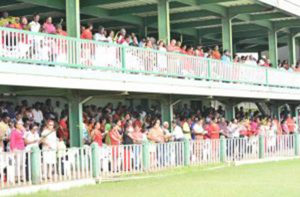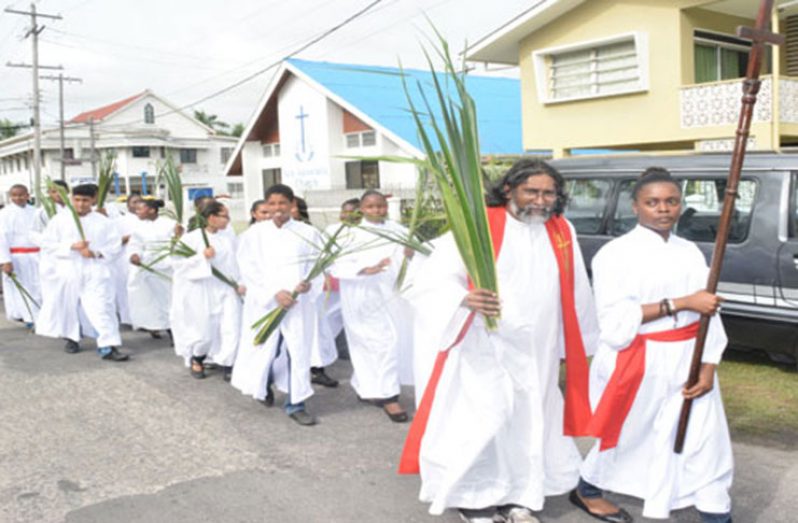Roman Catholics in Guyana, on Sunday joined fellow Catholics around the world in commemorating the sacred Feast of Palm Sunday.
In Georgetown the commemoration started off around 8:30 hrs, with the traditional blessing of palms and coconut fronds at Churches within their respective parishes, after which there was a spirited procession with parishioners wending their way through the streets, waving intricately designed symbols made using coconut palm fronds as they glorified King Jesus.
As they triumphantly processed through the streets, with a member of the laity carrying the cross, parishioners lustily sang hymns of praise and worshipped the King of Kings, at the end of which they culminated at identified Churches within their parish clusters for Holy Mass.
The palms used during the procession are blessed and surrendered at those Churches, and will later be burnt, in order to secure ashes which would be applied to members’ foreheads on Ash Wednesday next.

This symbolic engagement undertaken on Palm Sunday each year, is in commemoration of the triumphant entry of Jesus Christ into Jerusalem, meek and sitting on an ass (a young donkey). Thereupon, a great multitude, waving palms, and flocking as he rode into the city, cut down branches from the trees and venerated and glorified Him saying: Hosannah to the King of David: Blessed is He that cometh in the name of the Lord: Hosannah in the Highest.”
And as the scripture says: “All this was done that it might be fulfilled, which was spoken by the prophet saying: ‘Tell ye the daughter of Zion: Behold the King cometh unto thee, meek and sitting upon an ass and a colt the foal of an ass’.” (Matt. 21:5).
The triumphal entry is that of Jesus coming into Jerusalem on ‘Palm Sunday’ – the Sunday before the crucifixion (John 12:1, 12) The triumphal entry was a significant event, not only to the people of Jesus’ day, but to Christians throughout history. We celebrate Palm Sunday to remember that momentous occasion.
On that day, Jesus rode into Jerusalem on the back of a borrowed donkey’s colt, one that had never been ridden before. The disciples spread their cloaks on the donkey for Jesus to sit on, and the multitudes came out to welcome Him, laying before Him their cloaks and the branches of palm trees. The people hailed and praised Him as the “King who comes in the name of the Lord” as He rode to the temple, where He taught the people, healed them, and drove out the money-changers and merchants who had made His Father’s house a “den of robbers” (Mark 11:17).
Jesus’ purpose in riding into Jerusalem was to make public His claim to be their Messiah and King of Israel in fulfillment of Old Testament prophecy.



.jpg)









